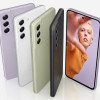Review: Sony Ericsson TM506
The TM506 is one of Sony Ericsson's more basic — but also more aesthetically pleasing — clamshell designs. It may be a bit on the blocky side, but I find it to be handsome. It has simple and clean lines that flow well. It rests comfortably in your hand whether open or closed. The weight and balance are good and it slips easily into a pocket.
The front is glossy black plastic. You know what that means. Smudges and finger grime will always be visible unless you constantly polish the front. Finger oils don't prevent you from being able to read the small front display, though. At the top of the front panel is the camera. I like that it is set back from the surface of the phone a little bit and has a beveled edge around it. This keeps your fingers from accidentally smudging up the camera lens.
The back of the TM506 is covered with a soft-touch paint job and has a matte black finish. This makes the TM506 easy to grip and hold in your hand. It isn't overly slippery.
On the left side of the phone is the hatch covering the M2 memory card port. While I fully understand that Sony Ericsson wants to protect its own memory card format, the entire rest of the cell phone industry has settled on microSD cards as the standard format for phone storage. M2 memory cards may be easy enough to find at your local big box eletronics retailer, but if you're upgrading from a phone that uses microSD cards, you won't be able to use your existing stock of cards. This will add to the price of the phone.
On the right side of the phone is only the volume toggle. It is a small silver dash that stands out visually and tactilely from the side of the phone. It is easily found and used. Travel and feedback are good.
The hinge of the TM506 is nice and sturdy. The build quality of this phone is top notch. I like how Sony Ericsson built the lanyard loop into the hinge.
I really like the design of the keypad on the TM506. It both looks good and works well. The layout is large enough that even those with the largest fingers aren't going to have trouble finding and using the keys. At the top of the keypad, the soft keys are two horizontal silver dashes. They stand out visually from the black surface of the keypad itself and also illuminate so they can be seen in the dark. These keys had adequate travel and feedback.
Below the soft keys are the send/end keys. These keys are flush with the surface of the phone. There is nothing to clue your fingers to their location, save for the fact that you'll know they are right below the soft keys. Below the send key on the left is the button for the shortcut menu and camera. Below the end key on the right is the Sony Ericsson clear key. All four of these keys have good travel and feedback.
The D-pad is ringed with a silver rim that is about the size of a quarter. The edge makes it stand out nicely from the surface of the phone. All four directionals and the center button have more travel and feedback than most other buttons on the phone, and were the most satisfying to use.
The numerical keypad itself is great. Even though it is flush with the surface of the phone, each key feels like a slight bubble as you pass your fingers over them. Despite the flat appearance, it is very easy to distinguish between keys as you move your thumb across the keypad.
There is a dedicated power button at the very bottom of the keypad. Sony Ericsson was wise to locate this button inside the phone, so it is not accidentally activated (shutting the phone off) when the phone is in your pocket or purse.
In all, the hardware just works.











 Video Tour: Sony Ericsson TM506
Video Tour: Sony Ericsson TM506
 iPhone 16 Brings More Features to All Price Points, Including New Camera Control
iPhone 16 Brings More Features to All Price Points, Including New Camera Control
 Samsung Revives S21 Fan Edition
Samsung Revives S21 Fan Edition
 Motorola's new Edge+ has Dual 50 Megapixel Rear Cameras and 60 on the Front
Motorola's new Edge+ has Dual 50 Megapixel Rear Cameras and 60 on the Front
 Sony's New $1,600 Flagship Sports Seamless True Optical Zoom
Sony's New $1,600 Flagship Sports Seamless True Optical Zoom
 Sony Ericsson TM506
Sony Ericsson TM506


